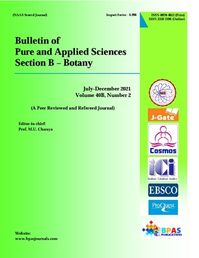Study of Some Cytotoxic Chemicals on Onion (Allium cepa L.) and Grass pea (Lathyrus sativus L.)
DOI:
https://doi.org/10.48165/Keywords:
Cytology, Chromosomal abnormality, Genotoxic effect, Mitotic indexAbstract
Chemicals that have adverse effects on normal cell division are called cytotoxic chemicals. Root Length, mitotic index and cytological studies of root tips in the presence of different cytotoxic agents were experimented on Onion (Allium cepa L.) and Grass pea (Lathyrus sativus L.). Different chromosomal abnormalities were observed from the root tip cytology. The root Length decreases most in higher concentration of the chemical with respect to control. The most frequent abnormalities are bridges, vagrant and stickiness ochromosome. Grass pea shows two additional abnormalities of pyknosis and karyorrhexis. The results show that the chemicals have toxic effects on both the samples. This study proves that besides onion, grass pea can also be used as effectively for cyto-genotoxic assessments for environmental toxic agents.
Downloads
References
. Antonise-Wiez, D. (1990).Analysis of the cell cycle in root meristem of Allium cepa under the influence of Ledakrin. Folia Histochemical Cytobiologia. Vol.26:79-96.
. Babatunde, B.B and Bakare A.A. (2006). Genotoxicity screening of waste from Agbara Industrial Estate, Nigeria evaluated with the Allium test. Pollution Research. Vol. 25(2):227-234. [3]. Bakare, A.A. Okunola, A.A. Adetunji, O.A. Jenmi, H.B. (2009).Genotoxicity assessment of Pharmaceutical effluent using four bioassays. Genetic and Molecular Biology. Vol. 32(2):373-381. [4]. Chakravarti, K. Naravaneni, R. Philip, G.H. (2007). Study of Cypermethrin Cytogenesis effects on Human Lymphocytes Using In-Vitro Techniques. J. Appl. Sci. Environ. Manage. Vol. 11 (2):77 – 81.
. Das, R.N. Parajuli, S. (2006). Cypermethrin Poisoning and Anti-cholinergic Medication- A Case Report. Internet Journal of Medical Update. Vol. 2:42-44.
. Fiskesj, Ö.G. (1997). Allium test for screening chemicals; evaluation of cytological parameters. Plants for environmental studies. Vol.101:307-333.
. Fiskesj, Ö.G. (1985a). Allium test on river water from Braan and Sexan before and after closure of a chemical factory. Ambiologia.Vol.14:99-103.
. Fiskesj, Ö.G. (1985b).The Allium test as a standard in environmental monitoring. Hereditas.; 102:99-102.
. Grant, W.F. (1982).Chromosome aberration assays in Allium. A report of the United States Environmental Proctection Agency Gene Toxicity Program. Mutation Research. Vol.99:273-291. [10]. Mishra, K. (1993). Cytotoxic effects of distillery waste on Allium cepa L. Bulletin Environmental Toxicology.Vol.50:199-204.
. Olorunfemi, D.I.E hwre, E.O. (2010).Chromosomal aberrations induced in root tips of Allium cepa by squeezed garriextracts. Report and Opinion. Vol. 2(12):166-171.
. Rank, J. Nielsen, M.H. (1997). Allium cepa anaphase-telophase root tip chromosome aberration assay on N-methyl-Nnitrosourea, maleic hydrazide, sodium azide and ethyl methanesulfonate. Mutation Research. Vol. 390:121-127.
. Rank, J. (2003). The method of Allium anaphase-telophase chromosome aberration assay. Ekologija.Vol. 1(1): 38-42.
. Samanta, A. Datta, S. Maity, T.R. Mandal, A. Datta, A.K. (2014). Assessment of methotrexate on dihydrofolate reductase activity, total RNA content and cell division of Lathyrussativus L.NucleusVol.57: 129-134.
. Sharma, K.R. (2011). Combined Effects of Copper and Cypermethrin on Growth and Biomass Accumulation in French Beans. Pesticide Research Journal Vol. 23(2): 224-226.
. World Health Organization. (1989). Environmental Health Criteria. Cypermethrin. (Vol. 82). Geneva: United Nations Environmental Programme, the International Labour Organization, and the World Health Organization.
. Samanta, A. Datta, S. Datta, A.K.Maity, T.R. Mandal, A. Das, D. (2015). Assessment of Cisplatin, Etoposide, Vinblastine and Piper betle leaf extract on some attributes of cell division in Lathyrussativus L.Cytologia.Vol.80 (4):483-488.
. Sharma, C.B.S.R. (1983). Plant meristems as monitors of genetic toxicity of environmental chemicals. Current Science. 52:1000-1002.
. Bindu, L. Balaram, P. Mathew, A. Remani, P. Bhattathiri, V. N. Nair, M. K. (2003). Radiation induced changes in oral carcinomacells—amultiparametric evaluation. Cytopathology. Vol. 14 (5):287–293.
. Sakhale, B.K. and Kapse, B.M. (2012).Studies on shelf life extension of sweet oranges (Citrus sinensis L.). International Food Research Journal, Vol.19 (2): 779–781.
. Mishra, D. (1988).Fungicides control of anthracnose and fruit rot of chilli. Indian Journal of Agricultural Sciences.Vol.58:147–149.
. Li, Y.F. (1999). Global technical hexachlorocyclohexane (HCH) usage and its contamination consequences in the environment: from 1948 to 1997. Sci Total Environ. Vol. 232: 121-158. [23]. Vijgen, J. Abhilash, P.C. Li, Y. F. Lal, R. Forter, M. (2011). Hexachlorocyclohexane (HCH) as new Stockholm Convention POPs-a global perspective on the management of Lindane and its waste isomers. Environ Sci Pollut Res Int.Vol.18: 152-162.




